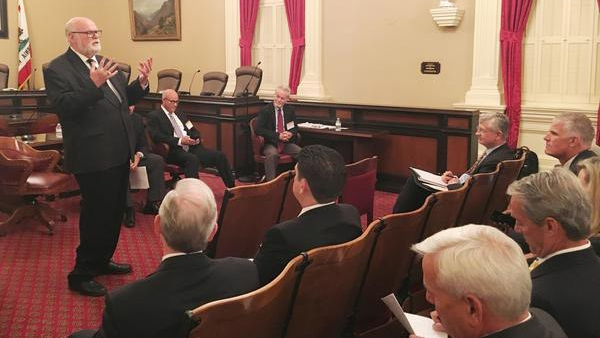
Sen. Jim Beall (D-San Jose) has agreed to carry legislation authorizing a $110 billion housing and transportation initiative.
In late February 2020, local leaders announced a plan to combine two ballot measures, long in the works, into one mega-referendum. As a result, voters in nine Bay Area counties could see a measure on the November 2020 ballot that could provide $110 billion over 40 years for transportation and housing.
This effort would confront two of the biggest challenges confronting the Bay Area, as anyone who’s ever been stuck on one of its freeways or tried to find so much as a studio apartment locally could attest.
Here’s how we got here.
The Original Two Measures
Originally, different groups were working on two separate ballot measures. These measures were as follows:
Faster Bay Area: The transportation measure proposed to provide $100 billion over 40 years via a sales tax and fees paid by major companies throughout the region.
San Jose Spotlight’s Janice Bitters reported in December 2019 that “state legislators in both the Senate and Assembly would have to agree in a two-thirds vote to allow residents to cast their own vote,” and that Sen. Jim Beall (San Jose) will author the bill.
Originally eyed for the November 2020 ballot, the measure has been in the works since 2017, with Faster Bay Area’s website noting that 275 community meetings have been held. Still, voter support has been uncertain, with a framework on the website noting 67 percent support for a 1 percent sales tax increase, which would be just barely enough to clear the two-thirds approval needed for special taxes under California’s Prop. 13.
The measure was spearheaded by Silicon Valley Leadership Group, Bay Area Council, and the San Francisco Bay Area Planning and Urban Research Association (SPUR).
● Bay Area Housing for All:This was originally intended as a $10 billion general obligation bond for the November 2020 ballot. The measure’s website notes, “Decades of disinvestment—estimated at an annual shortfall of $2.5 billion—have put the Bay Area into our current housing crisis. We need our elected officials to put forth big, bold solutions, and we need them to do it now.”
There could be voter support behind a bold ballot measure, with the Non-Profit Housing Association of Northern California noting that 79 percent of residents stated “that making housing more affordable is a priority issue for them. The state legislature also cleared the way for a housing measure to make the ballot by passing AB 1487 last year (though legislative approval is still needed for a transportation measure, San Jose Spotlight noted).
Still, leaders have expressed some reluctance about putting two separate measures on the November ballot.
Why the Two Measures Might Be Combined
Simply put, the two-thirds voter approval requirement under Prop. 13 is a high bar for special taxes to clear, with a January poll from EMC Research showing that the two measures wouldn’t get enough support if they showed up separately on the ballot, according to San Jose Spotlight. In addition, leaders have begun to make the case that transportation and housing affordability are inextricably linked, with San Jose Mayor Sam Liccardo telling Spotlight that people have realized, “The fact that their coworker is commuting 90 minutes every morning and night is linked to the fact that the same coworker can’t afford a home in our valley.”
What Kinds of Projects the Two Measures Could Bring
A summary four-point planned posted on Faster Bay Area’s website calls for a $100 billion investment in a regional transit network as well as “fundamental changes that allow us to make transit seamless across the Bay Area and deliver projects cheaper,” a $30 billion investment from employers to help solve the problem, and a first-in-state program to provide low-income residents with a 50 percent discount on transit and ensure they don’t have to pay for this project.
Plans are less spelled out on Bay Area Housing for All’s website, though $10 billion could provide at least 13,000 units of affordable housing, based on a Wall Street Journal estimate from 2018 of $750,000 per unit in California. An Urban Land Institute program in Sacramento in February floated an estimate of $400,000 per unit, which would equal 25,000 affordable housing units from $10 billion.
Long form articles which explain how something works, or provide context or background information about a current issue or topic.